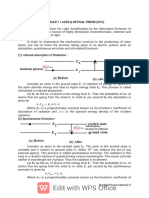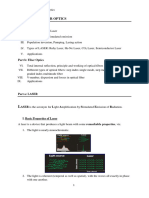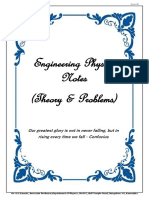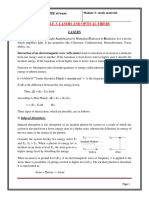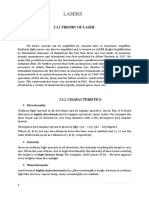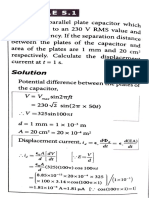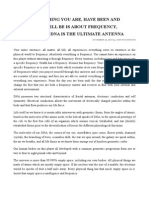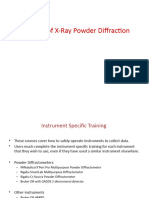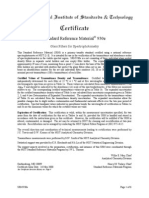Unit 2
Unit 2
Uploaded by
Padma PaduCopyright:
Available Formats
Unit 2
Unit 2
Uploaded by
Padma PaduOriginal Title
Copyright
Available Formats
Share this document
Did you find this document useful?
Is this content inappropriate?
Copyright:
Available Formats
Unit 2
Unit 2
Uploaded by
Padma PaduCopyright:
Available Formats
Engineering Physics
UNIT-II: Lasers and Electromagnetic waves
LASER is the acronym for Light Amplification by Stimulated Emission of Radiation.
Laser is a source of highly intense, monochromatic, coherent, parallel beam of light.
LASER principles: When radiation interacts with the matter, there will bea change in the
quantum system of the matter. The energy level of the atoms or molecules present in the matter
will change. To understand it properly, let us consider a two level energy system of the matter
as shown in the figure. Let E2 and E1 be the two energy levels of a system, such that E2>E1.
When radiation of frequency, [ν = (E2 – E1)/h] interacts with the system, there is a transition
in the system. By absorbing the energy of photon, the energy of atoms or molecules of the
system will increase from E1 to E2. The process is called as absorption.
There are three possible ways of interaction of photon with matter. One, the absorption, and
the other two are emission processes namely spontaneous emission and stimulated emission
as suggested by Einstein in 1917. All the three processes are discussed in detail by considering
an atom as a system.
Induced Absorption:
When an atom absorbs the incident photon of energy hν = (E2 – E1), it excites to a higher
energy level (E2) from lower level or ground state (E1), the interaction is called as Induced
Absorption. The process could be represented by,
atom + photon (hν)=atom*
atom* represents an atom in excited state.
School of Physics Page 1 of 19
Engineering Physics
Spontaneous Emission:
It is the emission of photon, when an atom in an excited (E 2) state makes a transition to a
lower energy state (E1) without the aid of any external agency. The emitted photons have
random nature (Incoherent).
ie. atom* =atom + photon (hν)
Stimulated Emission:
Stimulated Emission is the emission of a photon by an atom under the influence of stimulating
photon of right energy hν = (E2 – E1) due to which the atom makes a transition from a higher
energy state (E2) to a lower energy state (E1).
The two photons (Stimulating photon and stimulated photon) emerging out are in the same
direction, phase, energy and frequency. Hence they are ‘Coherent Photons’.
atom* + photon (hν) = atom+2 photons (hν)
Expression for Energy density U (ν) in terms of Einstein’s co-efficients and comparison with
Planck’s law of radiation
Consider a system of two energy levels E1& E2 containing N1& N2 number of atoms
respectively. N1 and N2 are called as number densities of E1 and E2 respectively. Let U(ν) dν
is energy density (Number of photons incident/unit volume of a system considering only those
radiations of frequency ν and ν+dν) incident on the system.
Case 1) Induced absorption: In this case, when radiations [U(ν)] falls on the system, atoms
make a transition from lower energy level to higher energy level (E1 to E2). The number of
such transitions per sec. per unit volume is called as rate of induced absorption.
Rate of induced absorption N1U(ν)
= B12 N1U(ν) (1)
School of Physics Page 2 of 19
Engineering Physics
Where, B12 is proportionality constant and is called as Einstein’s coefficient of induced
absorption.
Case 2) Spontaneous emission: In this case atoms will take transition from higher energy
level to lower energy level (E2 to E1) without any external aid (automatically). Number of
such transitions per sec. per unit volume is called rate of spontaneous emissions.
Rate of spontaneous emission N2
=A21N2 (2)
Where, A21is proportionality constant and is called as Einstein’s coefficient of spontaneous
emission.
Case 3) Stimulated emission: In this case atoms will take transition from higher energy level
to lower energy level (E2 to E1) with stimulation of external photon called stimulating photon.
Number of such transitions per sec. per unit volume is called rate of stimulated emissions.
Rate of stimulated emission N2U(ν)
=B21N2U(ν) (3)
Where, B21is proportionality constant and is called as Einstein’s coefficient of stimulated
emission.
Under thermal equilibrium condition
Number of transitions from E1 to E2 = Total number of transitions from E2 to E1
B12N1U(ν) = A21N2 + B21N2U(ν)
The coefficient A21, B12& B21 are called ‘Einstein’s Co-efficients’.
Rearranging the above equation
U(ν) [B12N1 - B21N2] = A21N2
A21N2
U(ν) = (4)
B12N1 −B21N2
(Dividing both the Nr and Dr by N2B21)
School of Physics Page 3 of 19
Engineering Physics
A21 / B21
U(ν) = (5)
(B12N1/ B21N2)) −1
From Maxwell-Boltzmann statistics, number of atoms (N1) in a given energy level is given by
k → Boltzmann Constant, T → Absolute Temperature, Ei = Energy of that level
−E1⁄ −E2⁄
N1 = e( 𝑘𝑇)N
2 = e( 𝑘𝑇)
N1 (−(E1−E2)⁄ ) ((E2−E1)⁄ ) ((hν)⁄ )
=e 𝑘𝑇 = e 𝑘𝑇 =e 𝑘𝑇 (6)
N2
Substituting equation (6) in (5), we get
𝐴21 1
𝑈(𝜈) = [𝐵 ]---------(7)
ℎ𝑣
𝐵21 12 (𝑘𝑇 )
𝐵21 𝑒 −1
This is the expression for energy density in terms of Einstein’s coefficient.
Comparing with Planck’s law
8𝜋ℎ𝑣3 1
𝑈(𝜈) = [ ]---------(8)
𝐶3 ( ℎ𝑣 )
𝑒 𝑘𝑇 −1
From Planck’s law of Radiation
Comparing equations (7) & (8), we find
𝐴21 8𝜋ℎ𝑣3 and
= 𝑐3
𝐵21
𝐵12
𝐵21
=1
i.e. B12= B21
which means the number of stimulated emission is generally equal to number of induced
absorption.
Conditions for Light Amplification by Stimulated Emission of Radiation
Population Inversion: The condition where the number of atoms in the higher level exceeds
number of atoms in lower level is called ‘Population Inversion’.
Metastable States: In the excited state, atoms stay only for 10-8s. Metastable states are
intermediate states as shown in the below figure where the lifetime of atoms is ≈ 10 -3s. This
property will help to achieve population inversion.
School of Physics Page 4 of 19
Engineering Physics
Requisites of laser system
Optical Pumping: The process of supplying energy to the medium to excite atoms from lower
energy state to higher energy state is called pumping. If visible light is used for this purpose
it is called ‘Optical Pumping’.
Active Medium: It is a system or substance which has suitable energy level system so that
population inversion and consequently light amplification is possible.
Optical Cavity/ Laser cavity: It is the space between two mirrors or reflecting surfaces
wherein the photons travel repeatedly to and fro until a strong laser beam is obtained whose
length is L= mλ/2 as shown in figure. Where, λ is wavelength of the Laser and m is an integer.
Laser cavity
Mirror Active medium Mirror
Active medium
L=mλ/2
Semiconductor (Gallium Arsenide) laser
A semiconductor (Ga-As) diode laser is a specially fabricated p-n junction device that
emits coherent light when it is forward biased.
Reflecting surface
Power
p-type LASER
n-type
Rough end surface
Construction:
The p material is obtained by doping Ga-As with Zinc and the n type by doping with
Tellurium. A p-n junction is formed with a highly doped semiconductor material (Gallium
arsenide). The junction is connected to a d.c. supply in a forward bias condition. The junction
forms the active region. The front and back faces are polished parallel to each other and
School of Physics Page 5 of 19
Engineering Physics
perpendicular to the plane of the junction. These two polished faces constitute the optical
resonator. The other two opposite faces are rough end to prevent lasing action in that direction.
Working:
A simple way of achieving population inversion in a semiconductor is to use it in the form of
a heavily doped p-n junction and to forward bias the junction. With very high doping on n-
side valence band as well as a portion of the conduction band are occupied by electrons and
Fermi level lies within the conduction band. Similarly heavily doped p-side the conduction
band is unoccupied and holes exist in the valence band and the Fermi level lies within the
valence band. At thermal equilibrium Fermi level is uniform across the junction.
When a forward bias is applied to the junction the energy levels shift and new distribution is
as shown in fig. Electrons and holes are injected in to the depletion region. At low forward
current level electron-hole recombination causes spontaneous emission of photons (LED) and
non radiative transitions.
As the current is increased, intensity of emitted light increases linearly. When the current
reaches a threshold value the carrier concentration in the depletion region will reach high
value. The upper levels in the depletion are having high population density of electrons and
lower levels in the same region are vacant. That is the state of population inversion.
Thus the forward current plays the role of pumping agent in the semiconductor laser. If
a photon having energy slightly greater than the band gap energy is incident such a photon
will stimulate large number of downward transitions of the electrons from the conduction band
to valence band. The stimulated electron hole recombination causes emission of coherent
radiation. As the recombination and hence the emission of light occurs only in the junction,
all the semiconductor lasers are edge emitters.
The energy gap (Eg) of GaAs is 1.4 eV, the wavelength of the emitted light is
λ = (hc/Eg) = 840 nm.
Characteristics of LASER beam
School of Physics Page 6 of 19
Engineering Physics
Directionality: Since the laser cavity mirrors reflects only those photons which are incident
in a direction normal to their own planes, photons moving to other direction will fail to return
to lasing media and thereby get suppressed.
Coherent: Coherent is the most important property which distinguish the laser light
from other types of light. If the phase difference between the two waves is same then they
are said to be coherent.
Monochromatic:Laser is a highly monochromatic beam of light. Its monochromaticity is
about 10 million times better than that of sodium source.
Highly intense: The intensity of laser is so much high that, the light from 1 mW He-Ne laser
is 100 times more intense than the light starting from the surface of the sun.
Focussability: Laser can be focused using lens. The diameter of the focused spot will be close
to the wavelength of the focused light.
Ex: He:Ne laser can be focused to nearly 6823Å spot.
Applications:
Lasers are used
1. As a source of light signals in fibre-optic communication
2. As optical memory unit in computers
3. In endoscopes to examine the internal organs of the human body and to perform bloodless
surgeries
4. In LASER guided missiles and bombs in Defense
5. For navigation in aircrafts
6. In display, they are used in laser shows
7. For welding and drilling of metals and alloys
8. For the creation of holographic images.
School of Physics Page 7 of 19
Electromagentic waves
Electromagnetic waves or EM waves are waves that are created as a result of vibrations
between an electric field and a magnetic field.
Characteristics of Electromagnetic Waves
Listed below are some important characteristics and properties of electromagnetic waves.
• Electromagnetic waves are transverse in nature as they propagate by varying the electric
and magnetic fields such that the two fields are perpendicular to each other.
• Accelerated charges are responsible to produce electromagnetic waves.
• Electromagnetic waves have constant velocity in vacuum and it is nearly equal to
3x108ms-1
1
which is denoted by C =
o o
• Electromagnetic wave propagation does not require any material medium to travel.
• The inherent characteristic of an electromagnetic wave is its frequency. Their frequencies
remain unchanged but its wavelength changes when the wave travels from one medium
to another.
1
• The refractive index of a material is given by: n =
r r
• Electromagnetic wave follows the principle of superposition.
• The light vector (also known as the electric vector) is the reason for the optical effects
due to an electromagnetic wave.
• In an electromagnetic wave, the oscillating electric and magnetic fields are in the same
phase and their magnitudes have a constant ratio. The ratio of the amplitudes of electric
E
and magnetic fields is equal to the velocity of the electromagnetic wave. C = o
Bo
• The energy is carried by the electric and magnetic fields of electromagnetic waves are
equal, i.e. the electric energy (UE) and the magnetic energy (UM) are equal;
• There is a vector quantity S, called the Poynting vector which represents the energy
transferred by electromagnetic waves per → second
1 → per unit area.
S=
EB
Electromagnetic Spectrum
Type of
wave Production Applications Issues
Communications (radio and
television) Requires control for
Radio Accelerating charges
Remote controls band use
MRI
satellite communications
Accelerating charges and Ovens
Microwaves
thermal agitation Radar
Cell phone use
Thermal imaging Absorbed by
Thermal agitation and
Infrared Heating atmosphere
electronic transitions
Greenhouse effect
Photosynthesis
Thermal agitation and Human vision
Visible light
electronic transitions Fibre optic
communications
Thermal agitation and Sterilization Ozone depletion
Ultraviolet
electronic transitions Vitamin D production Cancer causing
Security
Inner electronic transitions
X-rays Medical diagnosis Cancer causing
and fast collisions
Cancer therapy
Nuclear medicine Cancer causing
Gamma rays Nuclear decay
Security Radiation damage
Type of
wave Production Applications Issues
Medical diagnosis
Cancer therapy
Use of EM waves in communication
Radio waves
Radio waves are used for communication such as television and radio.
Radio waves are transmitted easily through air. They do not cause damage if absorbed by the
human body, and they can be reflected to change their direction. These properties make them
ideal for communications.
Producing radio waves - Higher
Radio waves can be produced by oscillations in electrical circuits. When radio waves are
absorbed by a conductor, they create an alternating current. This electrical current has the same
frequency as the radio waves. The conductor could be, for example, an aerial on a radio.
Information is coded into the wave before transmission, which can then be decoded when the
wave is received. Television and radio systems use this principle to broadcast information.
You might also like
- Photographic Characteristics of X-Ray FilmDocument18 pagesPhotographic Characteristics of X-Ray FilmSarvesh Zambaulikar100% (1)
- Parts of Microscope and Their FunctionsDocument3 pagesParts of Microscope and Their Functionsiammiiie0183% (6)
- UNIT - 3 (Light Semiconductor Interaction)Document26 pagesUNIT - 3 (Light Semiconductor Interaction)Comp105Jyot Kalathiya100% (1)
- Module 1 - Lasers & Optical Fibers-SN-FinalDocument26 pagesModule 1 - Lasers & Optical Fibers-SN-FinalJNo ratings yet
- Laser Notes For EEE StudentsDocument5 pagesLaser Notes For EEE Studentssuparnaankitha9No ratings yet
- Laser and Optical FiberDocument32 pagesLaser and Optical FiberKiran ThunuguntlaNo ratings yet
- CSE PHYSICS Notes-FormulaDocument102 pagesCSE PHYSICS Notes-FormulaLikhit NLNo ratings yet
- Laser and Optical FiberDocument21 pagesLaser and Optical FiberAbcdNo ratings yet
- Unit 4 Laser and Of, 21PH12 - 22Document54 pagesUnit 4 Laser and Of, 21PH12 - 22Laksh HeeraNo ratings yet
- VPN 4Document21 pagesVPN 4bhagavancheekatla31No ratings yet
- Lasers:, WhereDocument13 pagesLasers:, WhereMR ESPIANNo ratings yet
- Unit 1 Laser and Optical Fibre PDFDocument44 pagesUnit 1 Laser and Optical Fibre PDFTechMine HDNo ratings yet
- Laser NotesDocument11 pagesLaser NotesRohith0% (1)
- Laser SystemDocument19 pagesLaser Systemvaidgunmala5678No ratings yet
- Module 1 - LASERS - CSE - UPRDocument11 pagesModule 1 - LASERS - CSE - UPRcpanusha2116No ratings yet
- Module 1 1 8Document8 pagesModule 1 1 8rakshaNo ratings yet
- Lecture NotesDocument93 pagesLecture NotesadamjosephNo ratings yet
- Laser Lecture 2Document7 pagesLaser Lecture 2Aditya Nath MishraNo ratings yet
- laser notesDocument9 pageslaser notesnandasree262No ratings yet
- Leacture Notes Unit 2 1 37Document37 pagesLeacture Notes Unit 2 1 37keregiNo ratings yet
- Physics Unit 3Document120 pagesPhysics Unit 37csnty5wvgNo ratings yet
- 3-LASERSDocument11 pages3-LASERSaiman.work.meNo ratings yet
- 1.laser Cse 2024 Part 1Document7 pages1.laser Cse 2024 Part 122No ratings yet
- Applied Physics Unit 1 Notes (Lasers & OFC) CS StreamDocument32 pagesApplied Physics Unit 1 Notes (Lasers & OFC) CS StreamRaghavNo ratings yet
- LasersDocument16 pagesLasersCharan ReddyNo ratings yet
- Lasers and Optical FiberDocument35 pagesLasers and Optical Fibernikhilshreearun.me18No ratings yet
- BPHYE202Document25 pagesBPHYE202amoolyarao123No ratings yet
- Physics 5 VasudevanDocument70 pagesPhysics 5 VasudevanPritika RajendiranNo ratings yet
- LaserDocument15 pagesLaserkaran5singh-12100% (1)
- Be 201 Engineering Physics Unit 5Document37 pagesBe 201 Engineering Physics Unit 5wryrtf fhghNo ratings yet
- Laser BestDocument32 pagesLaser BestASHVINSINH DODIYANo ratings yet
- LASERSDocument20 pagesLASERSbinayk8935No ratings yet
- Lasers Notes-By Dr. Mahesh S Bannur VDIT HaliyalDocument20 pagesLasers Notes-By Dr. Mahesh S Bannur VDIT Haliyalgoutami SunthankarNo ratings yet
- Laser NotesDocument10 pagesLaser Notespruthirajnayak525No ratings yet
- Lasers NotesDocument9 pagesLasers Notes12 Dhanya ShriNo ratings yet
- Unit 3 2Document25 pagesUnit 3 2Sujith.VetriMaaranNo ratings yet
- LASERDocument12 pagesLASERrishitibest123No ratings yet
- Einsteins Coefficients-Ruby LaserDocument15 pagesEinsteins Coefficients-Ruby LaserthadiboinaNo ratings yet
- Physics Module 1 (CSE)Document24 pagesPhysics Module 1 (CSE)Monisha RNo ratings yet
- 2.1 LasersDocument20 pages2.1 LasersVaibhaviNo ratings yet
- Module 1 - LasersDocument11 pagesModule 1 - Laserssundae00clauseNo ratings yet
- Final Laser Converted 07.07.2021Document64 pagesFinal Laser Converted 07.07.2021Mahir MittalNo ratings yet
- Laser Notes 2017-1Document13 pagesLaser Notes 2017-1skacNo ratings yet
- Lasers NotesDocument14 pagesLasers NotesAnirudha KrishnaNo ratings yet
- Lasers - An Engineering IntroductionDocument14 pagesLasers - An Engineering IntroductionBharath ManchikodiNo ratings yet
- I: Lasers and Optical FibersDocument41 pagesI: Lasers and Optical FibersVaibhavNo ratings yet
- Lecture-1 Lasers Physics BasicsDocument23 pagesLecture-1 Lasers Physics BasicsDr-Walid FemtosecondNo ratings yet
- Module 4 ModeifiedDocument51 pagesModule 4 ModeifiedULtraSwoRDFiSHNo ratings yet
- LASERDocument27 pagesLASERRAMHIRDAY RAYNo ratings yet
- Lasers and Optical Fibers Mod-3Document31 pagesLasers and Optical Fibers Mod-3Syed ShaNo ratings yet
- Laser PDFDocument23 pagesLaser PDFsaurabkhatiwodaNo ratings yet
- LasersDocument24 pagesLasersWaseem AkramNo ratings yet
- Notes For Module 5Document36 pagesNotes For Module 5Sano ManjiroNo ratings yet
- LASERand OFDocument16 pagesLASERand OFpurvjain10No ratings yet
- Lasers Notes (Oct - 2023)Document18 pagesLasers Notes (Oct - 2023)plikith35No ratings yet
- LASER NotesDocument11 pagesLASER Noteskumarravi955rNo ratings yet
- LaserDocument6 pagesLaserAbhigyan BaruahNo ratings yet
- Lasers Notes Btech in EngineeringDocument17 pagesLasers Notes Btech in Engineeringakash DongeNo ratings yet
- Einstein Relation, Population InversionDocument4 pagesEinstein Relation, Population Inversionharishchandjaiswar1No ratings yet
- Feynman Lectures Simplified 2B: Magnetism & ElectrodynamicsFrom EverandFeynman Lectures Simplified 2B: Magnetism & ElectrodynamicsNo ratings yet
- Feynman Lectures Simplified 2C: Electromagnetism: in Relativity & in Dense MatterFrom EverandFeynman Lectures Simplified 2C: Electromagnetism: in Relativity & in Dense MatterNo ratings yet
- Unit 3Document15 pagesUnit 3Padma PaduNo ratings yet
- Unit 4Document47 pagesUnit 4Padma PaduNo ratings yet
- Unit 4Document30 pagesUnit 4Padma PaduNo ratings yet
- Unit-1 NotesDocument20 pagesUnit-1 NotesPadma PaduNo ratings yet
- Path Loss Definition Overview and FormulaDocument4 pagesPath Loss Definition Overview and FormulavtayadeNo ratings yet
- Session 2 Fundamentals of Colorimetry and Practical Color MeasurementsDocument74 pagesSession 2 Fundamentals of Colorimetry and Practical Color MeasurementsMarce MangaoangNo ratings yet
- Physics ENDocument212 pagesPhysics ENAlexSpiridon100% (1)
- Optics Lab ReportDocument2 pagesOptics Lab ReportMehwish IlyasNo ratings yet
- Dudley 2006Document50 pagesDudley 2006Maruf MorshedNo ratings yet
- Laser Systems - The Basics: Generation of A Laser BeamDocument2 pagesLaser Systems - The Basics: Generation of A Laser BeamDjordje KapetanovicNo ratings yet
- Theon Sensor - NS-467C Night Weapon Sight - Jan 2012 PDFDocument2 pagesTheon Sensor - NS-467C Night Weapon Sight - Jan 2012 PDFvanhien982001No ratings yet
- Tag Heuer - Lenses Technical BriefDocument18 pagesTag Heuer - Lenses Technical Briefapi-747268285No ratings yet
- Illuminance Level RequiredDocument4 pagesIlluminance Level RequiredKhurram Shahzad RizwiNo ratings yet
- 5 Electromagnetic Waves Sum QuestionDocument5 pages5 Electromagnetic Waves Sum QuestionDhanush Raman100% (1)
- Everything Is About Frequency and Dna Is AntennaDocument6 pagesEverything Is About Frequency and Dna Is AntennaPrestigio100% (3)
- NE300 ManualDocument20 pagesNE300 ManualBryan GiranoNo ratings yet
- Edited Action ResearchDocument32 pagesEdited Action ResearchEdz SoretsellaBNo ratings yet
- Led Bulbs CatalogueDocument30 pagesLed Bulbs CatalogueleedarsonlightingNo ratings yet
- Field Wave Electromagnetic PDFDocument2 pagesField Wave Electromagnetic PDFJoseNo ratings yet
- Gr11 Phy P1 (English) June 2019 Question PaperDocument16 pagesGr11 Phy P1 (English) June 2019 Question Paperora mashaNo ratings yet
- 06 Human Eye and Colourful World Chapter Wise Important Questions PDFDocument12 pages06 Human Eye and Colourful World Chapter Wise Important Questions PDFTannu KaurNo ratings yet
- Schreder The Reference in LightingDocument20 pagesSchreder The Reference in LightingCornel SimocNo ratings yet
- Asmi Structural Analysis 01Document103 pagesAsmi Structural Analysis 01Olga SNo ratings yet
- Optical Fibre Experiment ReportDocument3 pagesOptical Fibre Experiment Reportharsh guptaNo ratings yet
- Physics SQP - 05 Latest (2023) Class 12 CBSEDocument27 pagesPhysics SQP - 05 Latest (2023) Class 12 CBSEmr mindNo ratings yet
- Crime - UV and Body FluidsDocument3 pagesCrime - UV and Body FluidsDiyana ChirilaNo ratings yet
- Nist-Srm 930eDocument6 pagesNist-Srm 930eGoudafoneNo ratings yet
- InstrumentationDocument4 pagesInstrumentationRainneTayNo ratings yet
- Annex III Amc 20-158Document36 pagesAnnex III Amc 20-158philip00165No ratings yet
- PhotopediaDocument625 pagesPhotopediaedwintaufik87No ratings yet
- 3M 2800-2802-2805 Data SheetDocument2 pages3M 2800-2802-2805 Data SheetMichael TadrosNo ratings yet
- Test Jason QUANTUM PHYSICS FOR BEGINNERS - The New Comprehensive Guide To Master The 7 Hidden Secrets of The Law of Attraction and Relativity.Document36 pagesTest Jason QUANTUM PHYSICS FOR BEGINNERS - The New Comprehensive Guide To Master The 7 Hidden Secrets of The Law of Attraction and Relativity.acmcNo ratings yet


















